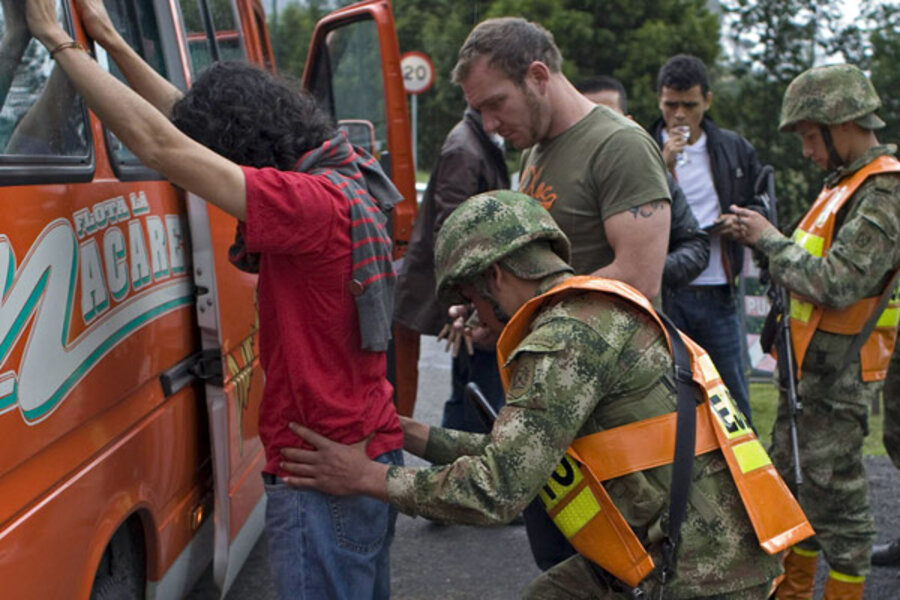Ahead of Colombia's elections, violence stalks candidates
Loading...
Colombia has seen 41 candidates killed in the run-up to the local elections, in an explosion of violence that does not bode well for the progress of democracy in the country.
Local politics is a deadly business in Colombia, even, or especially, in its small towns. Liberal candidate Luis Gonzalo Martinez was seen as promising contender for mayor of Magui Payan, in Nariño. His profile was boosted by his maverick platform and promises to clean up one of Colombia’s poorest and most violent regions. But he lacked the support of the illegal armed groups that vye for control of this strategic coca-producing province, and was gunned down while campaigning in a dangerous neighborhood on October 14, just over two weeks ahead of the October 30 vote.
As with so many other candidates murdered during the current election season, it is not known who killed Mr. Martinez. What is known, however, is that the area is host to nearly all of the major armed actors in the country, including the rebel Revolutionary Armed Forces of Colombia (FARC) and the National Liberation Army (ELN) as well as neo-paramilitary groups like the Rastrojos and Aguilas Negras. Over the past several months, these groups and others have been responsible for a wave of election-related violence across the country.
According to a report released this week by the independent Electoral Observation Mission (MOE), 41 candidates and potential nominees have been killed since the electoral process began in February of this year. Most of the victims are at the local as opposed to the department level, among them 24 town councilor candidates, 15 mayoral candidates, and two "ediles," (neighborhood representatives). Perhaps because of their greater resources and stronger security details, no candidates for governor have been killed, although a gubernatorial contender from Guajira was shot at a rally on October 9.
In total, the MOE has recorded 159 “violent incidents,” which include the killings as well as 23 attempted murders, seven kidnappings, and 88 death threats over the course of this year. As indicated in the map on the original post, the two departments which saw the most election-related violence in the past eight months were Antioquia and Valle del Cauca, which witnessed 7 and 12 assassinations, respectively. Both departments are focal points for both the armed conflict and criminal activity, which has taken a toll on the electoral process.
Of the 147 municipalities in which the MOE documented political violence against candidates, the organization found that 39 of them have a significant presence of one or more armed group. Antioquia and Valle del Cauca were also the departments with the most overlap between violence and armed groups, suggesting that it is these groups, and not common criminals, that are the real drivers of the political violence.
But while the MOE report is impressive in its scope, its broad, numbers-based take on the violence may obscure more of the issue than it reveals. There is such a wide range of factors that contribute to electoral violence, and such a high prevalence of criminal groups, that it is too simplistic to say a candidate was targeted simply because of the presence of one armed group in one particular area. For one thing, some of the assassination victims themselves had shady dealings and have been linked with criminal groups.
At the national level, there are several political parties with suspected links to paramilitary groups. As La Silla Vacia notes, the National Integration Party (PIN), the Movement for Inclusion and Opportunities (MIO), and the Afrovides Movement are all headed by ex-Senator Juan Carlos Martinez, who is currently imprisoned in Barranquilla for connections to the United Self-Defense Forces of Colombia (AUC).
Collusion between criminal groups and politicians is especially common in poor, urban areas, where the rule of law is weak and is frequently supplanted by the authority of street gangs. Often, these gangs develop relationships with local political bosses, offering an extra incentive for the community to support the party’s candidate. One example of this is in Medellin, where certain neighborhoods are completely closed to local politicians’ campaigns. According to a recent report in Semana magazine, political parties have been warned by gangs of young men not to campaign a quarter of the city’s 16 comunas, because the neighborhood "already has a candidate."
Ultimately, the violence and influence of criminal groups leaves little room for optimism about the health of Colombia's democratic process. The number of violent incidents has increased by seven percent from the most recent local elections, in 2007. In terms of assassinations, the latest round of elections saw a jump of about 52 percent, up from 27 in that year. Meanwhile, the number of municipalities with a presence of armed groups has diminished. This means that, for all of the government’s talk of improved security, armed groups and criminal organizations alike are still able to exercise political influence. It is true that the problem cannot be solved overnight, but unless the government invests more in providing security to candidates at all levels of government, it is unlikely to get better any time soon.
--- Geoffrey Ramsey is a writer for Insight – Organized Crime in the Americas, which provides research, analysis, and investigation of the criminal world throughout the region. Find all of his research here.





